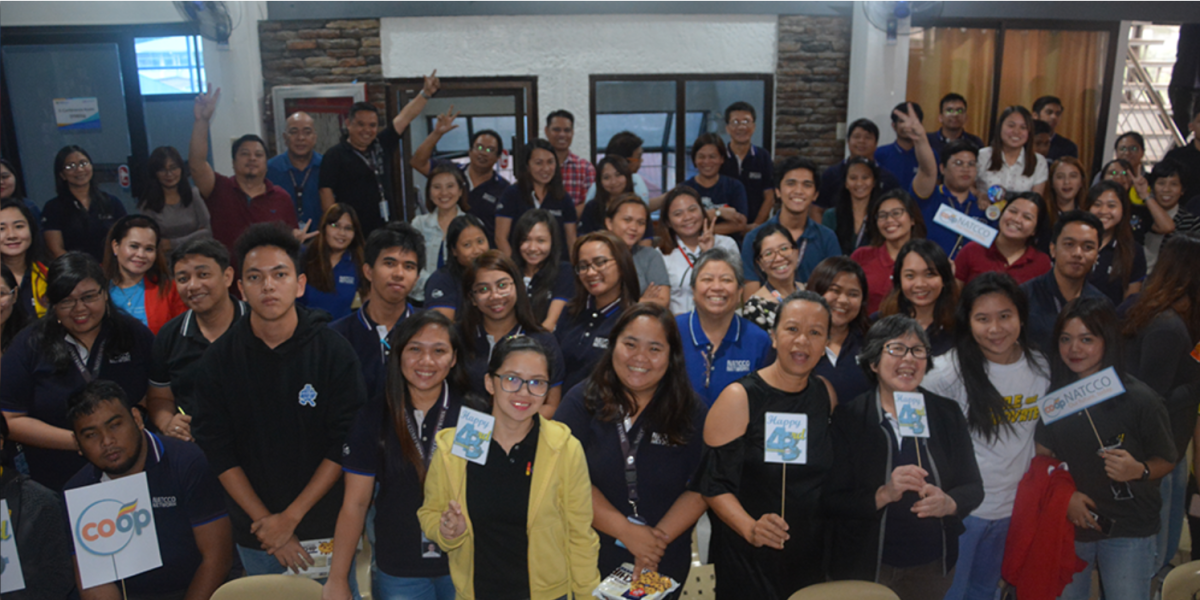NATCCO turns 43!
NATCCO staff celebrated the 43rd year of the National Confederation of Cooperatives at the headquarters today. NATCCO began as the National Association of Training Centers for Cooperatives, formed by co-op leaders who believed that the task of co-op development lay primarily in the hands of the private sector. These leaders also believed in Self-Help and in the idea that people could create opportunities for themselves to improve the economic well-being – if they co-operate.
These leaders had the benefit of hindsight, as well as vision for the future: from 1915 when the first co-op law was passed until the late 50s, co-ops did not succeed because they were just government initiatives.
But from the late 50s, co-op sector leaders were aware that in order to succeed they could not rely on government alone. Instead, co-ops had to be driven and patronized by their members and it is only through co-op education that this level of member patronage, commitment and responsibility could be established.
By the 1960s, primary cooperatives were established through the Catholic Church, by virtue of the Documents of the Vatican II’s emphasis on social justice. A number of primary cooperatives had also formed five regional co-op training centers (secondary cooperatives).
In 1972, President Ferdinand Marcos declared Martial Law, abolished Congress, shut down media, and drafted a new Constitution. Marcos issued Presidential Decree 175 in April 1973, “Strengthening the Cooperative Movement,” that required farmers to be organized into village associations called “Samahang Nayon.”
Furthermore, all types of existing cooperatives were required to re-register and conform to the Samahang Nayon structure. The move created tension between the Martial Law regime and the co-operative leaders.
Nevertheless, co-op leaders complied with the Martial Law impositions. The Marcos Regime jailed four co-op leaders in – Mordino Cua, Bienvenido Ferrer Jr., Ricardo Arboladura, and Viola Casino of SPECC in Mindanao – suspected as part of the “Third” rebel group. The first ‘rebel group’ was the political opposition; and second were the Communists, Socialists, Oligarchs, and Muslim rebels. These rebel groups were either jailed, killed, or exiled by the Marcos Dictatorship.
On January 23, 1977, amidst suspicions and harassment, the leaders of five regional training centers met in Cebu City and formed NATCCO to coordinate and standardize services for cooperatives at the national level. NATCCO also served as the voice of co-ops in the country.
The five training centers were Mindanao Alliance of Self-Help Societies – Southern Philippines Education Center for Cooperatives (MASS-SPECC), Visayas Cooperative Training Center (VICTO), Bicol Cooperative Training Center (BCTC), Tagalog Cooperative Training Center (TAGCOTEC), and North Luzon Cooperative Development Center (NORLUCEDEC).
After the EDSA Revolution in 1986, President Corazon Aquino ushered the 1987 Constitution that mandated Government to “promote the viability and growth of cooperatives as instruments of social justice and economic development.”
On April 1, 1989, the NATCCO transformed into a multi-service national co-op federation while the five regional training centers became multi-service co-op development centers. The acronym ‘NATCCO’ was retained and its meaning converted to the present “National Confederation of Cooperatives.”
Strategic Planning began in 2000, and the 2002 General Assembly resolved to conduct a study to restructure the Network from a three-tier into a two-tier organization, which happened in 2004.
Some federations that had formed or joined NATCCO would leave eventually.
But NATCCO’s Transformation Journey continued. Growth in the following years was exponential.
Today, NATCCO is the biggest federation of co-ops in the Philippines in terms of geographical reach, membership, financial capacity, and array of services. It serves 837 co-operatives that, in turn, serve a combined membership 5.8 million individuals members.
These 5.8 million individual members are served through 2,062 offices located in 77 provinces and 129 cities.

